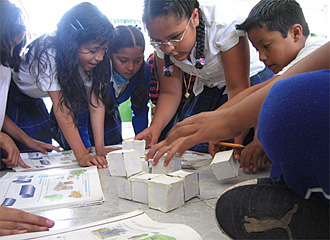
|
 |
 |
 News Around the Republic of Mexico | May 2008 News Around the Republic of Mexico | May 2008  
Mexico's Objective: Better Education = Better Jobs
 PVNN PVNN


| | Fourth-graders use paper blocks during a lesson on calculating volume at Estado de Mexico Primary School in Tultitlan, Mexico. (Chris Hawley/USA Today) | | |
Mexico City — It was early afternoon and 312 students at Estado de Mexico Primary School in the Mexico City suburb of Tultitlan were just beginning their school day.

Some students had been working all morning at their families' businesses, Principal Juan Humberto Benítez said.

"How many kilos of tomatoes do you sell in a day?" he asked 11-year-old Pedro Miguel Martínez, who works in his family's vegetable distributing company.

"About 120 kilos," or roughly 265 pounds, Martínez answered immediately.

The principal chuckled. "The ones who work," Benítez said, "are really good with numbers."

Their exchange helps illustrate the challenges and the promise of Mexican schools, where many students must balance education with their family's economic needs. The poor quality of public education here has become a growing concern as Mexico embarks on a new push to modernize and create better paying jobs that could slow the flow of migrants to the USA.

Test scores in Mexican schools rank below some other developing nations, and dropout rates compare poorly with those in the USA.

Last month, President Felipe Calderón called for an overhaul of Mexico's school system. "We need a reform that gives Mexico the right conditions to educate its students," Calderón said in a speech.

At a recent teacher training session in Mexico City, many educators said change will be difficult. "It's not just the quality of the schools, it's the economy," said Susan Espín, a sixth-grade teacher. "Out in the countryside, attendance is poor because the kids have to work to support their families. In the suburbs, you have 40 or 50 kids in each class because the population growth is so intense."

Over the long term, the deficiencies of Mexico's schools could have serious consequences for the United States, said George Grayson, an expert on Mexico at Virginia's College of William & Mary. Poorly educated immigrants take longer to assimilate and lack the skills that U.S. companies need to compete, he said.

At many Mexican schools, there is a morning shift and an afternoon shift, each about five hours long, compared with the seven or eight hours that American students spend in school. No lunch is served, but children get a free box of strawberry-flavored milk and snacks.

The Mexican government spends one-seventh what U.S. schools spend per student: $1,522 a year, compared with $10,071.

"We don't have the things that they have in the United States that allow the students to spend all day at school: the playing fields, the cafeterias, the showers, the specialized attention," said Ismael Vidales, a researcher at Mexico's Center for Advanced Studies and Research in Pedagogy.

Only 47% of students who enter vocational high schools graduate, according to Mexico's National Institute of Statistics, Geography and Information Processing. In college-prep high schools, the graduation rate is 60%.

In the United States, 75% of all high school students graduate.

In December, the Organization of Economic Cooperation and Development published the results of the PISA, a test it gives every three years in schools around the world. Among the 30 countries that participated, Mexico came in last place in science, math and reading.

To free up working children to attend school, the Calderón administration has promised to increase the number of grants to students' families from 4.8 million a year to 5.7 million by 2012. It has also promised to install distance-learning equipment in every classroom and introduce full days at 5,000 schools.

The government's plan would also tighten requirements for teachers, introduce new ways to monitor their performance and mandate training for teachers in schools with poor scores on standardized tests.

Mexican high school seniors took a national test last week to help pinpoint schools' weak points.

Whether the changes will work depends a lot on Mexico's economy and how much money it has to spend on education, researcher Vidales said.

"The problem is not just training teachers or bringing up test scores," he said. "The challenge is bringing up Mexico in general." | 
 | |
 |



